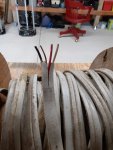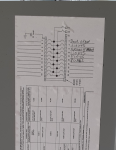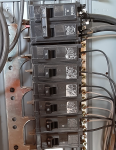- Joined
- Mar 6, 2020
- Messages
- 1,889
- Points
- 601
- City
- 48022
- State - Country
- MI - USA
- Vehicle Year
- 1994
- Vehicle
- Ford Ranger
- Engine
- 4.0 V6
- Transmission
- Automatic
- Total Lift
- 1-1/2 inch front leveling
- Total Drop
- Stock
- Tire Size
- 31/10.50/15
- My credo
- What's the worst that could happen?
I've been following Jim's new house and workshop and some of the things he's doing parallel mine -- electrical for instance -- although mine is in much better shape. I want to add a couple of circuits and perhaps a 220 line. The barn has a 60A box with maybe six circuits for lights and outlets. I have about 100 feet of this:

Pretty sure it's what you call 14/3 (the numbers on the casing are obliterated). I've read up a little on adding a 220 line and think I can use this wire for that, but still would like your opinions. I also want to add a couple more outlets, especially at the workbench area and along the new wall I just added.
Is my little 60 gonna do the trick or should I call in a pro and upgrade it to like 100 or 200?
Thanks in advance.
r

Pretty sure it's what you call 14/3 (the numbers on the casing are obliterated). I've read up a little on adding a 220 line and think I can use this wire for that, but still would like your opinions. I also want to add a couple more outlets, especially at the workbench area and along the new wall I just added.
Is my little 60 gonna do the trick or should I call in a pro and upgrade it to like 100 or 200?
Thanks in advance.
r















